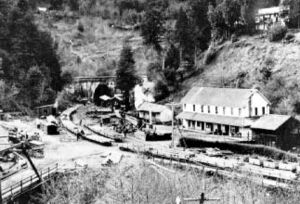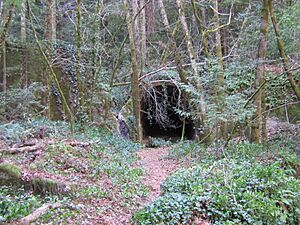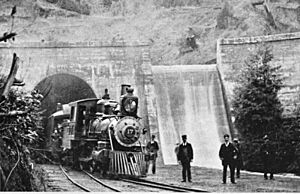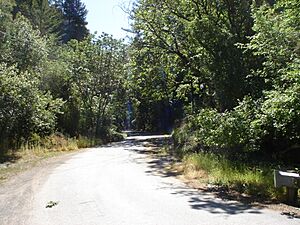Wrights, California facts for kids
Quick facts for kids
Wrights, California
|
|
|---|---|
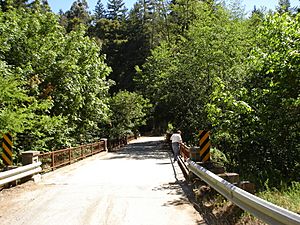
Bridge over Los Gatos Creek, Wrights Station Road, May 2008
|
|
| Country | United States |
| State | California |
| County | Santa Clara |
| Elevation | 991 ft (302 m) |
| Time zone | UTC-8 (Pacific (PST)) |
| • Summer (DST) | UTC-7 (PDT) |
| GNIS feature ID | 238202 |
Wrights, California (also known as Wrights Station) is a ghost town in western Santa Clara County, California. It is located near Summit Road in the Santa Cruz Mountains. You can find it on the north bank of Los Gatos Creek, east of State Route 17.
Wrights was once a busy place. It was one of many towns in the Santa Cruz Mountains that grew in the late 1800s. These towns, like Laurel, Wrights, Glenwood, and Clems, became ghost towns. This happened when the Los Gatos-Santa Cruz railroad stopped running in 1940. Later, Patchen was bypassed by a new highway. Alma and Lexington were even covered by Lexington Reservoir in 1952.
The area is on the San Andreas Fault, a major fault line. Because of this, Wrights was badly damaged in the 1906 San Francisco earthquake. Geologists saw the ground move about 4.6 feet (1.4 meters) sideways there.
Contents
A Town Built by the Railroad
In the 1870s, a toll road was built over the mountains. It went from Los Gatos to Santa Cruz. Stagecoaches used this road. Then, a narrow gauge railroad was built along the same path. It started in 1877. This railroad was built by James Fair and Alfred E. Davis. They led the South Pacific Coast Railroad (SPCRR).
One of the railroad stops was near the land of James Richards Wright. He had a home and hotel called Arbor Villa. He also grew fruit trees and grapes. The small community that grew around this stop became known as Wright's Station, or just Wrights.
James Richards Wright was from a large family. His brother, Elizur Wright, was famous for working to end slavery. One of James's sons, Frank Vincent Wright, married Susie Davis. She was the daughter of the railroad president, Alfred Davis. Another son, Sumner Banks Wright, started a town called Wrightwood. Today, Wrightwood is a ski resort.
Building the Wrights Tunnel
A post office opened in Wrights in 1879. The railroad was finished in 1880. It ran from Los Gatos to Wrights Station. During the building of Wrights Tunnel (between Wrights and Laurel), a lot of natural gas was found. An explosion happened, killing 32 Chinese workers. The main gas leak was stopped, but small amounts still escaped.
Old maps from 1919 show the railroad running from Los Gatos to Santa Cruz. It had stops like Alma, Wrights, Laurel, and Felton. There were many tunnels, including a 6,200-foot (1,900-meter) tunnel between Wrights and Laurel. Most of these tunnels were later blocked when the railroad closed.
Life in Wrights
Wrights Station was a key place for shipping fruit. By the 1890s, about 3,200 acres (13 square kilometers) of land were used for farming. The soil was good for growing things.
People planted vineyards to grow grapes for wine makers. Companies like Almaden Vineyards and Paul Masson used these grapes. There was also a busy timber industry. They used the redwood trees from the Santa Cruz Mountains. All these businesses used the railroad. Wrights Station was one of the small towns that grew along the railroad line.
Fire and Rebuilding
Alice Matty and her father, Antone, moved to Wrights in 1880. Antone worked in the general store. In 1885, a fire started in the town's hotel. It burned down the entire settlement. While Wrights was being rebuilt, Antone ran the store from a boxcar on the railroad tracks.
In 1887, a journalist named Josephine McCracken visited Wrights. She wrote that the town had a "depot, hotel, store, post office, blacksmith shop." She also mentioned "Chinese stores and wash houses." She described the "hideous black mouth of the great tunnel" nearby.
By 1888, Antone Matty had saved enough money to buy the store. By 1896, he owned the whole town. The Matty family had six children. So, Antone helped start a school district. Soon, the town had a school. The Wright School was used until 1928. Highlands School was built in 1929 to replace it. Children of farmers, like William Elza Lawrence's eight kids, went to Highlands School.
The Highlands School closed after only 10 years. The number of people in Wrights dropped a lot. This happened because the new State Route 17 highway did not go through Wrights. Antone Matty later joined groups that worked to save the redwood trees.
The 1906 Earthquake
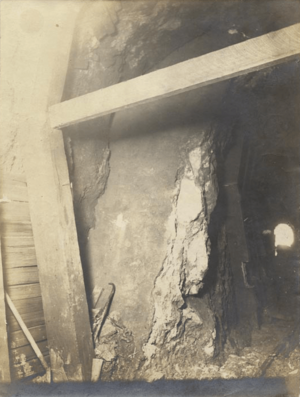
The Southern Pacific Railroad bought the narrow gauge SPCRR railroad. They started special picnic trains. They opened an area called "Sunset Park" near Wrights. They brought trainloads of people into the Santa Cruz mountains. But visitors often left trash and damaged the train cars.
The 1906 earthquake ended these excursion trains and Sunset Park. Many homes in the area were destroyed. A crack opened under one house, splitting it in two. The earthquake also destroyed bridges, damaged tunnels, and twisted the railroad tracks. A large crack opened in the dirt road near the blacksmith shop. The 6,200-foot (1,900-meter) railroad tunnel was badly damaged.
Alice Matty, Station Agent
Alice Matty, her sisters, and brothers grew up in Wrights. When the station agent left, Alice was chosen to take his place. She became the first woman station agent hired by Southern Pacific in California.
Her job was very busy. She wrote down details for shipments of hay, beans, prunes, and figs. These goods would fill two or three train cars a day. Shipping lumber was even bigger than all other goods combined. Freight trains and passenger trains passed through Wrights every day.
Alice Matty was also a telegraph operator and sold tickets. She used levers to switch trains onto different tracks. Wrights was in a canyon, so it had floods, rock slides, and forest fires. Alice often had to send telegrams for repair crews to clear rocks or fix the tracks after storms.
Alice Matty never married. She stayed in Wrights with her father until he passed away in 1922. Later, she worked at the Bank of America in Los Gatos.
The End of Wrights
The railroad was rebuilt after the earthquake. But it stopped running in 1940. This was because of a huge landslide caused by heavy rains. This disaster made Wrights decline even more. The post office had already closed in 1938. With no post office, no school, and often no roads or rails, farmers could not sell their goods. Many farmers left Wrights without being able to sell their farms.
The new State Route 17 highway, built away from Wrights in 1940, sealed the town's fate. Also in 1940, Arbor Villa, the Wright family home, burned down and was never rebuilt.
What's Left Today?
Today, Wrights has almost completely disappeared. You can still see the ruins of the old tunnel. Some building foundations and old pieces of the town can be found in the thick woods. Satellite pictures show that the area is now covered by dense forest.
The name of the town lives on in "Wrights Station Road." This road goes through the redwood forest. It crosses Los Gatos Creek on an old bridge. This bridge might be from the 1920s. It ends at the site where the town used to be. Lake Elsman, a reservoir, is also nearby.
Several miles of the old Los Gatos – Santa Cruz narrow gauge railroad have been saved. They are now a tourist attraction in Santa Cruz County. It's called the Santa Cruz, Big Trees and Pacific Railway. Trains run there all year round.
Weather at Wrights
A weather station operated at Wrights until 1986. It mainly recorded rainfall and snowfall.
- Wrights received about 46.09 inches (117.1 cm) of rain each year.
- It had about 1.2 inches (3.0 cm) of snow each year.
- The most rain in one year was 87.65 inches (222.6 cm) in 1983.
- The least rain was 17.88 inches (45.4 cm) in 1976.
- The most rain in one day was 13.79 inches (35.0 cm) on October 12, 1962. This was during the famous Columbus Day storm.
- The most snow in one year was 10.6 inches (27 cm) in 1974.
- The highest temperature recorded was 102°F (39°C) on August 5, 1978.
| Climate data for Wrights, California | |||||||||||||
|---|---|---|---|---|---|---|---|---|---|---|---|---|---|
| Month | Jan | Feb | Mar | Apr | May | Jun | Jul | Aug | Sep | Oct | Nov | Dec | Year |
| Record high °F (°C) | 84 (29) |
76 (24) |
80 (27) |
83 (28) |
91 (33) |
95 (35) |
95 (35) |
102 (39) |
96 (36) |
95 (35) |
80 (27) |
78 (26) |
102 (39) |
| Mean daily maximum °F (°C) | 52.4 (11.3) |
55.2 (12.9) |
59.8 (15.4) |
63.8 (17.7) |
68.1 (20.1) |
72.5 (22.5) |
75.9 (24.4) |
76.1 (24.5) |
70.3 (21.3) |
68.6 (20.3) |
61.6 (16.4) |
53.3 (11.8) |
64.8 (18.2) |
| Daily mean °F (°C) | 47.7 (8.7) |
50.1 (10.1) |
53.3 (11.8) |
56.0 (13.3) |
58.7 (14.8) |
62.5 (16.9) |
65.6 (18.7) |
65.5 (18.6) |
62.4 (16.9) |
60.9 (16.1) |
55.8 (13.2) |
48.3 (9.1) |
57.2 (14.0) |
| Mean daily minimum °F (°C) | 42.9 (6.1) |
45.1 (7.3) |
46.9 (8.3) |
48.2 (9.0) |
49.2 (9.6) |
52.4 (11.3) |
55.4 (13.0) |
54.9 (12.7) |
54.4 (12.4) |
53.1 (11.7) |
49.9 (9.9) |
43.3 (6.3) |
49.6 (9.8) |
| Record low °F (°C) | 29 (−2) |
27 (−3) |
35 (2) |
33 (1) |
38 (3) |
41 (5) |
42 (6) |
44 (7) |
40 (4) |
40 (4) |
32 (0) |
20 (−7) |
20 (−7) |
| Average precipitation inches (mm) | 9.52 (242) |
8.29 (211) |
6.54 (166) |
3.47 (88) |
1.04 (26) |
0.32 (8.1) |
0.08 (2.0) |
0.10 (2.5) |
0.63 (16) |
2.18 (55) |
5.57 (141) |
8.57 (218) |
46.31 (1,175.6) |
| Average snowfall inches (cm) | 0.9 (2.3) |
0.1 (0.25) |
0.4 (1.0) |
0.0 (0.0) |
0.0 (0.0) |
0.0 (0.0) |
0.0 (0.0) |
0.0 (0.0) |
0.0 (0.0) |
0.0 (0.0) |
0.0 (0.0) |
0.1 (0.25) |
1.5 (3.8) |
| Average precipitation days (≥ 0.01 in) | 10 | 10 | 10 | 6 | 3 | 2 | 0 | 1 | 1 | 4 | 7 | 9 | 63 |
| Source: Western Regional Climate Center | |||||||||||||




